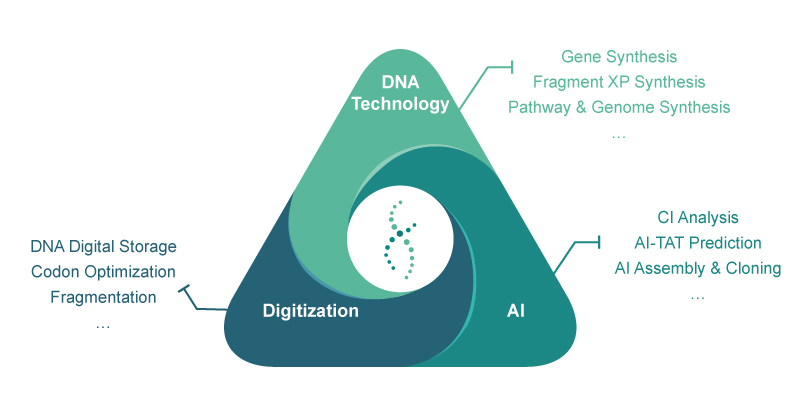Gene synthesis stands as a cornerstone, enabling researchers to create, modify, and study DNA sequences with unprecedented precision. This technology is pivotal for advancements in various fields, including synthetic biology, gene therapy, and biopharmaceutical production.
DNA Sequence Design
The journey of gene synthesis begins with the meticulous design of the DNA sequence. At Synbio Technologies, we leverage an internally developed system called the Complexity Index (CI) to tailor the DNA sequence according to specific needs or objectives. This proprietary system ensures that the designed sequence not only meets the functional requirements but also optimizes for synthesis efficiency and accuracy. The CI system takes into account various factors such as sequence length, GC content, repetitive patterns, and potential secondary structures, which can all impact the synthesis process. By employing this advanced design strategy, we can create custom DNA sequences tailored for a wide range of applications, from basic research to complex therapeutic constructs.
Once the DNA sequence is designed, the next step involves breaking it down into smaller, manageable fragments. These fragments, typically ranging from 200 to 1500 base pairs (bp), are known as oligonucleotides (oligos). The purpose of this segmentation is to facilitate chemical synthesis, as synthesizing long stretches of DNA directly is both challenging and error-prone. Each oligo is synthesized using automated oligonucleotide synthesizers, which build the sequence one nucleotide at a time through a series of chemical reactions. These oligos serve as the building blocks for the subsequent assembly process.
Fragment Assembly
With the oligos in hand, the next challenge is to assemble them into longer, contiguous DNA fragments. This is accomplished through various DNA assembly techniques, primarily divided into two categories: ligase-based assembly and polymerase chain reaction (PCR)-based assembly.
In ligase-based assembly, such as the Golden Gate cloning method, specific restriction enzymes are used to create compatible ends on the oligos, which are then ligated together by DNA ligase. This process can be iterative, allowing for the step-wise assembly of larger fragments from smaller ones.
PCR-based assembly techniques, on the other hand, utilize the amplification capabilities of DNA polymerases to assemble oligos into larger fragments directly. These methods often involve the use of primers that are complementary to the ends of the oligos, enabling them to be amplified and assembled into the desired sequence through cycles of denaturation, annealing, and extension.
After successful assembly, the next step is to clone the newly synthesized DNA fragment into a suitable vector. Cloning is crucial for several reasons: it provides a stable, amplifiable form of the gene, allows for easy manipulation and purification, and facilitates the introduction of the gene into various host organisms for further study or production. The cloned DNA is then transformed into bacterial cells, typically Escherichia coli, which are propagated to amplify the plasmid DNA.
Quality Control (QC) Verification
Ensuring the accuracy and integrity of the synthesized DNA sequence is paramount. Therefore, rigorous quality control measures are implemented at multiple stages throughout the process.
Sequencing technologies, such as Sanger sequencing or NGS sequencing, are employed to verify the exact nucleotide sequence of the synthesized DNA. Sanger sequencing provides high accuracy over relatively short sequences, while NGS sequencing allows for the rapid sequencing of entire genomes or large DNA fragments, providing comprehensive coverage and identifying potential errors or variants.
Agarose gel electrophoresis is another crucial tool used to analyze the size and integrity of the DNA fragments. By separating DNA fragments based on their size and charge, this technique allows for the visualization of the DNA fragments and the confirmation of their expected size range.
Restriction enzyme analysis further validates the structure and sequence of the synthesized DNA. Specific restriction enzymes are used to cut the DNA at known sites, and the resulting fragments are analyzed by gel electrophoresis to confirm their size and the presence of the expected restriction sites.
Shipment
Finally, with the DNA sequence verified and validated, it's ready for delivery. Customers simply provide us with the desired nucleotide or amino acid sequence, and we take care of the rest. We clone the synthesized gene into any vector of their choice, ensuring it's 100% accurate and ready for their specific application. Whether it's for research purposes, therapeutic development, or industrial production, we guarantee the highest quality and reliability in our gene synthesis services.
Gene Synthesis| Synbio Technologies
Gene synthesis is a highly sophisticated and multi-step process that requires precision, expertise, and advanced technology. From the initial design of the DNA sequence to the final delivery of the cloned gene, each step is critical for ensuring the accuracy and functionality of the synthesized DNA. By leveraging our proprietary systems, cutting-edge technologies, and rigorous quality control measures, we are able to provide customers with reliable and customizable gene synthesis solutions that cater to their unique needs.

Reference
[1] Hughes RA, Miklos AE, Ellington AD. Gene synthesis: methods and applications. Methods Enzymol. 2011;498:277-309.
 DNA Synthesis
DNA Synthesis Vector Selection
Vector Selection Molecular Biology
Molecular Biology Oligo Synthesis
Oligo Synthesis RNA Synthesis
RNA Synthesis Variant Libraries
Variant Libraries Genome KO Library
Genome KO Library Oligo Pools
Oligo Pools Virus Packaging
Virus Packaging Gene Editing
Gene Editing Protein Expression
Protein Expression Antibody Services
Antibody Services Peptide Services
Peptide Services DNA Data Storage
DNA Data Storage Standard Oligo
Standard Oligo Standard Genome KO Libraries
Standard Genome KO Libraries Standard Genome Editing Plasmid
Standard Genome Editing Plasmid ProXpress
ProXpress Protein Products
Protein Products
























